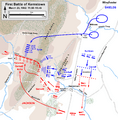First Battle of Kernstown facts for kids
Quick facts for kids First Battle of Kernstown |
|||||||
|---|---|---|---|---|---|---|---|
| Part of the American Civil War | |||||||
|
|||||||
| Belligerents | |||||||
| Commanders and leaders | |||||||
| Nathan Kimball | Stonewall Jackson | ||||||
| Strength | |||||||
| 8,500 (estimated) | 3,800 (estimated) | ||||||
| Casualties and losses | |||||||
| 590 total 118 killed 450 wounded 22 captured or missing |
737 total 139 killed 312 wounded 286 captured or missing |
||||||
The First Battle of Kernstown happened on March 23, 1862. It took place in Frederick County and Winchester, Virginia. This battle was part of the American Civil War. Even though Confederate General Stonewall Jackson was usually very successful, this battle was one of his rare defeats.
Contents
Why the Battle Happened
At the start of 1862, President Abraham Lincoln wanted his Union generals to attack the Confederacy strongly. General George McClellan was getting his army ready for a big plan called the Peninsula Campaign. His goal was to capture Richmond, the capital of the Confederacy, and end the war.
To do this, McClellan had to use many soldiers. This meant fewer soldiers were left to protect Washington, D.C.. Only two Union forces were left to guard the capital. One was General Nathaniel Banks's army in the Shenandoah Valley. The other was General Irwin McDowell's army in northern Virginia.
Banks was supposed to clear Confederate forces out of the Shenandoah Valley. Then, he would move closer to Washington. This would allow McDowell's large force of 30,000 soldiers to attack Richmond from the north. Banks left General James Shields with about 9,000 soldiers in the Valley. Banks then moved east to Manassas, Virginia, to be nearer to Washington, D.C.
Confederate General Stonewall Jackson was given an important job. He had to keep the Union Army busy in the Valley. This would stop them from joining McClellan's big attack. Jackson's cavalry leader, Colonel Turner Ashby, found out that some Union forces were leaving the Valley. He thought only a small group was left.
The Skirmish on March 22
Jackson gave Colonel Ashby permission to attack. Jackson then moved the rest of his soldiers to join Ashby. But Ashby's information was wrong. The Confederates thought they were attacking only about 3,000 Union soldiers. In reality, there were about three times that many Union soldiers hidden from view.
During this small fight, called a skirmish, General Shields was hurt. He then gave command of the Union soldiers to Colonel Nathan Kimball.
The Main Battle on March 23
Around nine o'clock in the morning on March 23, Ashby's cavalry attacked again. Colonel Kimball wasn't sure if it was just another small fight or the start of a big battle. To be safe, he put his soldiers in a strong defensive spot on Pritchard Hill. He also placed his artillery (cannons) there.
When Jackson saw this, he moved his cannons to Sandy Ridge, west of Pritchard Hill. Around three-thirty in the afternoon, Jackson realized something important from Sandy Ridge. The Union force he thought was small was actually much bigger. Jackson told one of his officers, "We are in for it." This meant they were in for a much harder fight than expected.
Kimball believed he was facing a much larger Confederate army. He decided to try and stop the Confederate cannons on Sandy Ridge. His attack met strong resistance from the Confederates. The battle soon became a stalemate, meaning neither side could gain an advantage.
Jackson kept sending in more Confederate soldiers. But he could not push the Union line back. Kimball still had fresh soldiers he could send into the fight. By six o'clock, the Confederate soldiers were running low on ammunition. They were also very tired. When one of Jackson's groups of soldiers ran out of ammunition completely, they had to leave the battle. The Union army attacked through the empty space they left. Jackson's entire force then had to quickly retreat.
After the Battle
Even though the Confederates lost this battle, it had a big effect. President Lincoln became worried about Washington, D.C. He thought Jackson's army was a bigger threat than it was. Because of this, Lincoln decided to keep Union soldiers in the Valley. He also held back McDowell's army from joining McClellan's attack on Richmond. This helped the Confederacy by making McClellan's job harder.
Images for kids
See also
 In Spanish: Primera batalla de Kernstown para niños
In Spanish: Primera batalla de Kernstown para niños






